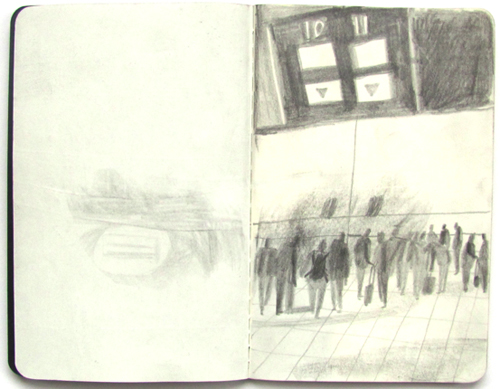|
For this project, I am investigating the idea of ‘place’. To help clarify ideas, it seemed obvious to begin by drawing the place I’m in, and through these drawings, investigate some of the different kinds of ‘places’ that exist. If the end product is an illustration, then it makes sense to think through drawing. I decided to begin this way after reading Rachel Gannon’s paper ‘Being there, conversational drawing in a non-place” (Gannon, 2013, pp. 68-77) The ‘Non-place’ project began as a month long residency at Luton Airport in August 1995. The brief was to record and document the space, travellers and staff as they went about their business, and to end with an exhibition at the airport. The drawings came from an initial interest in documentary, but during the process, the focus became one of the experience of drawing, and the experience of ‘drawing as thinking, not thought’ (Gannon 2013,p.69). She uses the dictionary definition of ‘drawn’, being drawn into a conversation, as a description of the way she works, ‘not a conversation with someone I know but with a stranger. Someone I am struggling to get to know, searching for common ground (Gannon 2013,p.72). I visit the local shopping Mall to make some drawings. It’s a good example of a non-place (Auge, 1995), and is full of people passing through, passing time, and waiting. Also, like the airport, Photography is forbidden (also so is drawing, but I find that out later). Drawing from life, gives a first hand account of the place. It is time based, so I’m recording 5 seconds -5 minutes in the lives of other people. Most of them are waiting for about the same length of time. Rachel refers to Berger’s idea that ‘photography stops time, whilst drawing encompasses it’. Drawings that take longer than the moment witnessed, are more a product of memory. (Gannon 2013,p.73). I only draw while they are in front of me. I prefer to draw from life. Photographic reference is often necessary when making an illustration, but if it’s possible I’ll always to try to collect reference for drawings from observation. It is easier to filter out unnecessary information, and to select at that point what the emphasis is going to be. I can take what I need and supplement later with a photo. I am also making notes for my blog so my written recording is simultaneous with the visual.
I began as an observer, not in their ‘place’. However, once, eye contact and occasionally, conversation has begun, my relationship changes with them and their place. Have I broken my own 4th wall? I am aware that I don’t want to change the relationship of observer and observed and that this affects whom I choose as subject. For example, singles and couples are usually absorbed in themselves and each other, whereas someone in a larger group will often disengage and also become an observer (and watch me). Perhaps this is what Rachel means when she writes about Fabians ‘denial of coevalness’ (Gannon, 2013 p73). His notion is that in the field of anthropology, there is a contradiction between people viewed as contemporaries and in dialogue, and those that are seen as ‘other’ and separate – and not inhabiting the same time and space as the observer. To try and understand this (and test myself), I drew a lot closer than I normally would and stood in clear view. All but two subjects were aware I was drawing them, three smiled (two at me, one to themselves, one got annoyed I think) and the rest ignored me. They all carried on as if I wasn’t there, and didn’t appear to modify their behaviour in any way. My conclusion is that there are two ways to approach on site drawing. Eiither dive in, become involved and be part of the event, or be a detached observer, collecting information. If I have permission to draw, then the first approach will yield the most information, but it needs more courage. Gannon, R. (2013) ‘Being there: Conversational drawing in a non-place’, VAroomLab, (2). Auge, M. translated by John Howe (1995),’Non-places: Introduction to an anthropology of Supermodernity’, Verso, London New York Comments are closed.
|
Archives
August 2020
Categories
All
|

 RSS Feed
RSS Feed